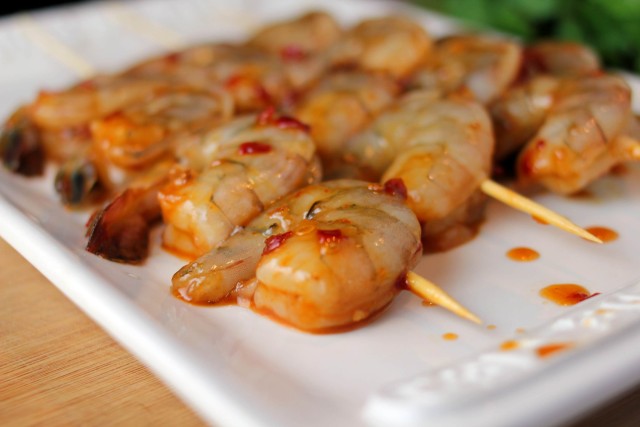 Fire up your engines to go fishing for SHRIMP in the Pacific Northwest!
Fire up your engines to go fishing for SHRIMP in the Pacific Northwest!
Enjoy the opener of Shrimp Fishing Season!
Try this Chef’s Recipe: Marinated Grilled Wild Fresh Caught Shrimp. Trout fishing is off and running at hundreds of lakes across the state, as spring chinook salmon continue to push into fishing areas higher and higher up the Columbia River Basin. In marine waters, fishing seasons for spot shrimp and halibut are set to open on various dates this month, when more razor-clam digs are scheduled on coastal beaches.
With new fishing opportunities opening throughout the state, May is a great time to go fishing, saya John Long, a fisheries manager for the Washington Department of Fish and Wildlife (WDFW). “Some of the most popular fisheries are available in May,” Long said. “So, if you like to fish, now is a great time to get out on the water.” For more about the season’s opening, read on after the recipe.
Chef’s Recipe: Marinated Grilled Wild Fresh Caught Shrimp. This recipe features a very simple and easy marinade that makes your shrimp so yummy that you don’t even need any cocktail sauce! It is also a big hit with company, and easy to prepare. Don’t let the cayenne pepper scare you, you and your guests won’t even taste it. No matter what, be sure to grill your shrimp, and pair your shrimp with a salad, baked potato, and garlic bread. You won’t be disappointed!
Ingredients:
3 cloves garlic, minced
1/3 cup olive oil
1/4 cup tomato sauce
2 tablespoons red wine vinegar
2 tablespoons chopped fresh basil
1 bunch cilantro
1/2 teaspoon salt
1/4 teaspoon cayenne pepper
2 pounds fresh shrimp, peeled and deveined
skewers
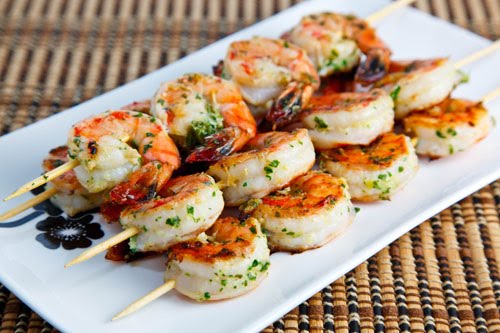 Preparing the Meal:
Preparing the Meal:
- In a large bowl, stir together the garlic, olive oil, tomato sauce, and red wine vinegar. Season with basil, cilantro, salt, and cayenne pepper.
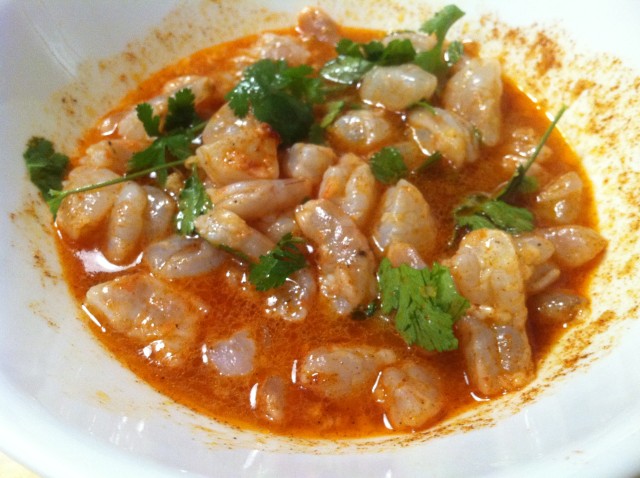 Seafood Takes Less Time to Marinade than Red Meat
Seafood Takes Less Time to Marinade than Red Meat
- Add shrimp to the bowl, and stir until evenly coated. Cover, and refrigerate for 30 minutes to 1 hour, stirring once or twice.
- Preheat grill for medium heat. Thread shrimp onto skewers, piercing once near the tail and once near the head. Discard marinade.
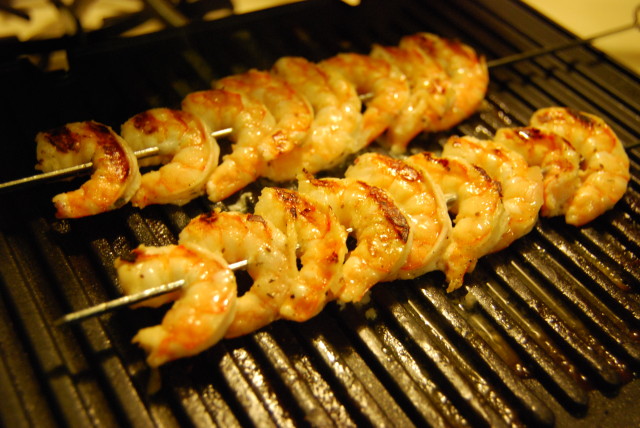 Don’t Overcook Your Shrimp
Don’t Overcook Your Shrimp
- Lightly oil grill grate. Cook shrimp on preheated grill for 2 to 3 minutes per side, or until opaque. Serve with salad & bread, or sides of choice.
May 13, 2015 – On Day Shrimp Fishing – NW Sport Fishermen Are Excited!
wdfw.wa.gov/fishing/shellfish/shrimp
Add shrimp, halibut to your catch of trout, chinook salmon in May:
wdfw.wa.gov/weekender
While every fishery has its fans, none draws bigger crowds than the lowland lakes trout-fishing season, which opened statewide on the last Saturday in April. Several hundred thousand anglers traditionally turn out for that event and most continue to fish for trout during the six-month season.
Catch rates at more than 100 Washington lakes on opening day are posted on WDFW’s website at http://wdfw.wa.gov/fishing/creel/lowland/2015.html.
To prepare for that day, WDFW planted more than 2 million trout ranging from 11-inch “catchables” to 11-pound lunkers. Now the tanker trucks are rolling again, delivering more fish to Washington lakes.
“We stock lakes with trout for the whole season, not just opening day,” said Chris Donley, WDFW Inland Fish Program manager. “Trout fishing should be highly productive in lowland lakes through June, and then again in September. However, some continue to fish well for trout and kokanee all summer. At higher elevation lakes, anglers should also find good fishing throughout the summer.”
For more information on lake fishing opportunities, check WDFW’s Fish Washington website at http://wdfw.wa.gov/fishing/washington/.
For most anglers, a valid 2015-16 fishing license is required to fish in Washington state. The exception is young people under age 15, who fish for free. Licenses are avaiIable online at fishhunt.dfw.wa.gov/, by phone (1-866-246-9453) and from sporting goods stores and other retail license dealers around the state. A list of license vendors is available at wdfw.wa.gov/licensing/vendors/ and from local WDFW offices.
North Puget Sound
(Island, King, San Juan, Skagit, Snohomish and Whatcom counties)
Fishing: The lowland lakes fishing season is officially under way and anglers will have opportunities to reel in some nice-size fish in May, and in months to come. Fisheries for spot shrimp and halibut also open this month in marine waters throughout the region.
Under statewide rules, anglers have a daily limit of five trout on most lakes. Released legal-sized trout caught with bait count toward the daily bag limit. Complete information on stocking schedules for rainbow, cutthroat and jumbo trout is available on the Washington Department of Fish and Wildlife’s (WDFW) website.
The department is adding more trout this month to several of the region’s lakes, including the following:
- Cranberry Lake in Island County;
- Alice, Beaver, Bitter, Boren, Deep, Desire, Dolloff, Echo, Fenwick, Fish, Fivemile, Geneva, Haller, Holm, Killarney, Meridian, Mill Pond, Old Fishing Hole, Shadow, Steel, Trout and Walker lakes in King County;
- Ballinger, Blackmans, Flowing, Shoecraft, Silver and Gissburg Ponds in Snohomish County;
- Depression and Padden lakes in Whatcom County.
Justin Spinelli, a fish biologist for WDFW recommends trolling slowly near the surface with small lures or flies. “This can be done on Washington lakes from float tubes, boats, kayaks or canoes,” he said. Anglers fishing trout from stationary boats or shoreline can be successful using bait or imitation flies under a bobber or by casting and retrieving small lures.”
Most western Washington lowland lakes that opened for trout in late April also have a largemouth bass, panfish (yellow perch, pumpkinseed sunfish, or bluegill) and catfish fishery, said Danny Garrett, another WDFW fish biologist.
“This is an excellent time to target these species as they move onshore to feed and spawn,” said Garrett. “By far, largemouth and smallmouth bass are the most popular draws for sport anglers this time of year, but many anglers will have great success on robust populations of panfish species and brown bullhead catfish.”
Additionally, a few select fisheries such as Green Lake in Seattle are bolstered by plants of channel catfish, which grow upwards of 30 pounds in western Washington lakes, said Garrett.
Youth fishing events are also beginning to pop up around the state. Visit the WDFW youth fishing calendar to find local family friendly opportunities to introduce kids to fishing.
For more tips, anglers should check online. The “Fish Washington” feature at the department’s homepage provides details on lowland lake fishing, high lake fishing and marine area opportunities.
For those planning fishing vacations this spring or summer, Great Washington Getaways is a WDFW web feature that showcases some of the state’s best family travel and fishing opportunities. Check out the new “urban shores” article for ideas on fishing destinations around Puget Sound.
And, for those who want even more fishing advice, the Fish Washington video page provides “how to” fishing videos designed to introduce techniques to both new and seasoned anglers.
Before heading out, anglers should check the fishing regulations. Unlike in past years, the current fishing rules pamphlet will remain valid through June 30, 2015.
Prefer shellfish? The popular spot shrimp season opened May 2 in Puget Sound. Also known as prawns, spot shrimp are the largest shrimp in Puget Sound and may grow up to nine inches in length.
Puget Sound opening days are as follows:
- Hood Canal Shrimp District (Marine Area 12): Open from 9 a.m. to 1 p.m. on May 2, 9, 11 and 13.
- Discovery Bay Shrimp District (Marine Area 6): Open from 7 a.m. to 3 p.m. on May 2, 9, 11 and 13.
- Marine areas 4 (east of the Bonilla-Tatoosh line), 5, 6 and 13 (excluding Discovery Bay Shrimp District): Open daily beginning May 2. The recreational spot shrimp season closes when the quota is attained or Sept. 15, whichever comes first. The exception is Marine Area 13, which closes for spot shrimp May 31.
- Marine Area 7 East, South: Open May 2 for a one-day fishery and will reopen May 13-16, May 20-23 and May 27-30.
- Marine Area 7 West: Open daily beginning May 2. The recreational spot shrimp season closes when the quota is attained or Sept. 15, whichever comes first.
- Marine areas 8-1, 8-2, and 9: Open from 7 a.m. to 3 p.m. on May 2 and May 13.
- Marine areas 10 and 11: Open from 7 a.m. to 3 p.m. on May 2. On May 13, the portion of Marine Area 10 west of a line from West Point to Alki Point will be open from 7 a.m. to 3 p.m. This includes the Bainbridge Island shrimp fishing grounds. Elliott Bay will remain closed on May 13 (Elliott Bay is defined as those waters east of a line from West Point to Alki Point).
In areas 4, 5, 6, 7 (East, South and West) and 13, start times will be one hour before sunrise.
In some central Puget Sound marine areas, the typical schedule of Saturday and Wednesday openings is disrupted Wednesday, May 6, due to an extremely low (or minus) mid-day tide. Those areas will be open the following Wednesday, May 13, instead.
Additional dates and times will be announced if sufficient quota remains after the initial fishing days scheduled above. For the latest information on sport shrimp seasons, or for a description of marine areas, visit WDFW’s recreational shrimp fishing website.
In all areas of Puget Sound, fishers are limited to 80 spot shrimp per day. A valid 2015-16 fishing license – including shellfish – is required to participate in the fishery. Saltwater anglers can also reel in halibut this month. Several areas of Puget Sound will open for the big flatfish in early May, including the following:
- Marine Area 5: The fishery will be open May 15 and 16; Thursday through Sunday of Memorial Day weekend, May 21-24; and May 29 and 30.
- Marine Areas 6, 7, 8, 9 and 10: The fishery will be open May 8 and 9; May 15 and 16; Thursday through Sunday of Memorial Day weekend, May 21-24; and May 28-30.
- Marine Areas 11, 12, 13: These areas will remain closed to halibut fishing to protect threatened and endangered rockfish species.
Heather Reed, coastal policy coordinator for WDFW, reminds anglers that there is a one-fish daily catch limit and no minimum size restriction for halibut. Anglers may possess a maximum of two fish in any form and must record their catch on a WDFW catch record card.
Reed also encourages anglers to use a descending device to release unwanted or prohibited rockfish. Using a descending device to return rockfish back to the depth of capture, or at least 60 feet, greatly improves their chance of survival.
South Sound/Olympic Peninsula
(Clallam, Grays Harbor, Jefferson, Kitsap, Mason, Pierce, Thurston and Pacific counties)
Fishing: Fishers can fill their shrimp pots in Puget Sound or head to the coast to catch halibut or hatchery chinook in May. Razor clam digging wraps up this month with openings at various ocean beaches.
Salmon fishing in Washington’s ocean waters gets under way in May. Anglers can fish for hatchery chinook in marine areas 3 (La Push) and 4 (Neah Bay) during two openings May 15-16 and May 22-23. Both areas, along with marine areas 1 (Ilwaco) and 2 (Westport/Ocean Shores) open daily for hatchery chinook beginning May 30.
In Puget Sound, anglers can fish for blackmouth salmon in Marine Area 13 (south Puget Sound). Those anglers who have a two-pole endorsement can fish with two poles. The area has a limit of two salmon daily, but anglers must release wild chinook.
Wild steelhead fishing wrapped up last month in coastal rivers. However, anglers can still retain two hatchery steelhead daily on the Quillayute and Sol Duc rivers. Those two rivers also are open for salmon fishing. Anglers can keep six fish daily, including two adults, but must release wild adult chinook and wild adult coho.
Sections of the Chehalis River also are open for salmon fishing in May with a one-fish daily limit.
Trout are biting at dozens of lakes throughout the region. On the north coast, anglers can try Wentworth Lake. Leland Lake in Jefferson County is scheduled to be stocked with 6,000 rainbow trout this month. Mission, Panther and Wildcat lakes in Kitsap County are each being stocked with more than 6,000 rainbow trout. Anglers in Mason County can head to Spencer or Phillips lakes where trout are also being stocked. Be sure to check WDFW’s online fish stocking reports before heading out.
Areas of Puget Sound and the coast will open for halibut fishing this month. In all marine areas open to halibut fishing, there is a one-fish daily catch limit and no minimum size restriction. Anglers may possess a maximum of two fish in any form and must record their catch on a WDFW catch record card. Details on Washington’s halibut fishing seasons can be found on WDFW’s halibut webpage.
Anglers can keep lingcod and Pacific cod while fishing for halibut in marine areas 5 and 6 only, noted Heather Reed, coastal policy coordinator for the Washington Department of Fish and Wildlife (WDFW). This is a change from 2014, when anglers could retain both cod species in marine areas 7-10. WDFW made the change to protect rockfish in marine areas 7-10, Reed said.
Anglers also will have additional opportunities in May to fish for lingcod. The season opens May 1 for hook and line fishing and May 21 to spearfishing for lingcod in marine areas 5, 6, 7, 8, 9, 10, 11 and 13. Fishing for cabezon opens May 1 in those same marine areas.
Meanwhile, May is the month that shrimpers wait for all year. Areas of Puget Sound opened May 2 for the recreational spot shrimp season. Fishers are limited to 80 spot shrimp per day in all areas. Check WDFW’s recreational shrimp fishing webpage for details.
Shrimp fans also can head to Brinnon’s Shrimpfest, an annual festival celebrating Hood Canal spot shrimp. The festival features food booths, live music and kids’ activities. Shrimpfest will be held May 23-24. Parking and admission information can be found on the Shrimpfest webpage.
Diggers can wrap up a lengthy razor clam season by hitting the beaches again this month. State shellfish managers approved a two-day dig May 2 and 3 and have tentatively scheduled three more openings this month, when the season is expected to end.
“We’ve had a remarkable year with more days of razor clam digging than we’ve had in decades,” said Dan Ayres, WDFW coastal shellfish manager.
Clam diggers can find the latest information on upcoming digs on WDFW’s razor clam webpage.
Youth fishing events are also beginning to pop up around the state. Visit the WDFW youth fishing calendar to find local family friendly opportunities to introduce kids to fishing.
For more tips, anglers should check online. The “Fish Washington” feature at the department’s homepage provides details on lowland lake fishing, high lake fishing and marine area opportunities.
For those planning fishing vacations this spring or summer, Great Washington Getaways is a WDFW web feature that showcases some of the state’s best family travel and fishing opportunities. Check out the southern coast article for an adventure filled with salmon, halibut and rockfish fishing.
And, for those who want still more fishing advice, the Fish Washington video page provides “how to” fishing videos designed to introduce techniques for both new and seasoned anglers.
Before heading out, anglers should check fishing regulations on WDFW’s webpage. Unlike in past years, the current fishing rules pamphlet will remain valid through June 30, 2015.
Southwest Washington
(Clark, Cowlitz, Klickitat, Lewis, Skamania and Wahkiakum counties)
Fishing: The month began with a two-day opening of the spring chinook sport fishery on the lower Columbia River on Saturday, May 2, and Sunday, May 3. High counts of spring chinook passing Bonneville Dam the previous week allowed the two states to reopen the fishery for at least two more days, said Ron Roler, Columbia River policy coordinator for the Washington Department of Fish and Wildlife (WDFW).
Federal fish counters at the dam counted more than 17,000 adult spring chinook salmon April 28 and 11,000 more April 29, prompting officials to raise this year’s estimated run size to at least 220,000 upriver fish.
“That’s a lot of fish over the dam in two days, and it really helped to boost confidence in this year’s spring chinook run,” Roler said. “We’ll be watching those numbers closely in the days ahead to see if we can give anglers some additional days on the water.”
Prior to that opening, the spring chinook fishery had been closed below Bonneville Dam since April 16, at which point angler had caught 10,130 upriver fish since the season began.
As before, the anglers fishing May 2-3 can retain one hatchery adult chinook salmon as part of their daily catch limit. The area reopening to spring chinook fishing extends from the Tongue Point/Rocky Point line upriver to Beacon Rock for boat and bank anglers, and to the fishing boundary below Bonneville Dam for bank anglers.
Anglers may also fish for shad and hatchery-reared steelhead when the spring chinook fishery is open. For both salmon and steelhead, wild fish with an intact adipose fin must be immediately released unharmed.
Whether or not the salmon fishery reopens later in May, anglers may retain hatchery steelhead and hatchery chinook jacks starting May 16 from the Rocky Point/Tongue Point line upstream to the I-5 Bridge.
Above Bonneville Dam, fishing for hatchery salmon and steelhead is currently set to run through May 6 from the Tower Island power lines to the Washington/Oregon state line, 17 miles upriver from McNary Dam. Bank anglers can also fish upriver from Bonneville Dam to the Tower Island power lines during that time.
Like those fishing below the dam, anglers fishing those waters can catch and keep one adult hatchery spring chinook as part of their catch limit.
Two new fishing rules in effect above Bonneville Dam:
- Allow anglers to possess up to four hatchery adult spring chinook salmon (four daily limits) in fresh form on the stretch of the Columbia River from The Dalles Dam upstream to the Washington/Oregon state line. This rule does not apply to fish kept while on a boat.
- Prohibit using a boat or other floating device to set lines for spring chinook and steelhead while fishing from the Washington bank when the Columbia River is open to fishing from the Tower Island power lines downstream to Bonneville Dam. Only hand-casted lines may be used.
Joe Hymer, a WDFW fish biologist, said anglers are likely to find this month’s best fishing for hatchery spring chinook in tributaries above Bonneville Dam – specifically the Wind River, Drano Lake and Klickitat River.
Under rules currently in effect as of May 1 at both Drano Lake and Wind River:
- Anglers may use barbed hooks to catch hatchery chinook and steelhead as specified in the rule change.
- Each angler aboard a vessel may deploy salmon/steelhead gear until the daily salmon/steelhead limit for all anglers aboard has been met.
- Boat anglers with a Two-Pole Endorsement may fish for salmon and steelhead with two poles.
In addition, the anti-snagging rule will be in effect on the Wind River from the Burlington-Northern Railroad Bridge upstream. Only fish hooked inside the mouth may be retained. Also, a night closure will be in effect upstream from Shipherd Falls which opens to fishing for spring chinook and hatchery steelhead starting May 1. Above Shipherd Falls any chinook – adipose-fin clipped or not – may be retained.
Drano Lake is closed to all recreational fishing on Wednesdays through June
Meanwhile, anglers continue to reel in some nice salmon and steelhead from tributaries flowing into the lower Columbia below Bonneville Dam. Fishing has been good on the Cowlitz River for springers at the barrier dam and for hatchery steelhead near the trout hatchery. The Lewis River remains closed to spring chinook fishing, but spring chinook fishing on the Kalama River has been extended until further notice.
The North Fork Lewis River from Johnson Creek (located below the salmon hatchery) upstream to Merwin Dam will be closed to all fishing during the month of May.
Hymer said prospects for summer-run hatchery steelhead are also good this month on the Kalama, East Fork Lewis, North Fork Lewis, and Washougal rivers. Selective fishing rules are in effect through early June on the lower East Fork Lewis and Washougal rivers. Selective gear will also be required on the lower Green and South Fork Toutle rivers when the early hatchery steelhead season gets under way the last Saturday in May.
Rather catch sturgeon? Anglers fishing The Dalles and John Day pools can retain legal-size until the respective catch guidelines for those waters are met. Legal fish measure 43 inches to 54 inches, fork-length. All sturgeon fishing is prohibited in the spawning sanctuaries below The Dalles, John Day, and McNary dams from May through July and from May through August below Bonneville Dam.
Walleye fishing has been good in The Dalles and John Day pools, and bass should start biting there and in Bonneville Pool as the water warms up.
Anglers fishing for warmwater fishing should also be aware that the 2015 Columbia River Pikeminnow Sport-Reward Fishery Program starts May 1. The program has a higher base reward ($5) and a newly revamped tier structure paying anglers up to $8 for each pikeminnow at least 9 inches in total length they catch from areas of the Columbia and Snake rivers. Specially tagged fish are worth $500. For more information call (800) 858-9015 or visit the website.
Just as soon catch some trout? Several trout streams stocked with feisty rainbows will open for fishing on the Saturday of Memorial weekend. Those waters include Canyon Creek and the upper Little White Salmon River in Skamania County, and Spring Creek in Klickitat County. WDFW is no longer planting Outlet and Bird creeks in Klickitat due to new recovery efforts under way for the Oregon spotted frog.
WDFW also will continue to stock lowland lakes with catchable-size trout. Those receiving additional plants in May include Kress and Horseshoe lakes in Cowlitz County; Battleground Lake in Clark County; Kidney Lake in Skamania County; and Spearfish and Horsethief lakes in Klickitat County. Due to the lack of snow this winter, many mountain lakes are accessible for fishing.
Anglers are reminded Swift Reservoir will not open until the first Saturday in June, as noted in the fishing pamphlet. The later opening is designed to protect downstream migrating salmon and steelhead smolts, which are part of an ongoing reintroduction program under re-licensing agreements with PacifiCorp.
Eastern Washington
(Asotin, Columbia, Ferry, Garfield, Lincoln, Pend Oreille, Spokane, Stevens, Walla Walla and Whitman counties)
Fishing: May is a prime fishing month throughout the region, where action is heating up both on waters that just opened and those that opened earlier this year. WDFW staff made creel checks on the April 25 opener and the average catch rates they tallied can be a good indication of how fishing will continue at least through this month.
In Spokane County, where conditions were mostly cold, wet and blustery, WDFW district fish biologist Randy Osborne reported anglers did well at many traditionally popular spots. Williams Lake produced 6.2 fish per angler, including a 21.5-inch rainbow and a couple of winter-carryover 20.5-inch tiger trout. Clear Lake anglers also averaged 6.2 fish each, including a 17.5-inch rainbow trout. Anglers at West Medical Lake averaged 4.6 fish each, including a 22-inch rainbow. Badger Lake produced an average of 1.4 fish per angler, with the largest fish a 21-inch rainbow. Fish Lake anglers averaged 1.3 fish each, including a 17-inch rainbow.
In Stevens County, Rocky Lake anglers averaged 5.7 fish each, and as WDFW district fish biologist Bill Baker said, every angler who wanted to keep fish limited out. Some anglers were strictly catch-and-releasing the rainbow trout that mostly ran 11-12 inches with carryovers of 14-18 inches. Waitts Lake anglers averaged six trout each, including rainbows up to 22 inches and brown trout up to 14 inches. Anglers at Starvation Lake averaged 4.7 trout each, with the largest measured at 16 inches. At Mudgett Lake, the average catch was 4.5 trout per angler, including carryover rainbows up to 19.5 inches. Deep Lake anglers averaged a limit of five trout each, most 11-inch rainbows and kokanee. At Cedar Lake, catch rates were lower at 2.9 fish apiece, but Baker said the fish were nice, with 15-17-inch carryovers.
In Pend Oreille County, anglers at Diamond Lake averaged 4.2 fish each, with the largest measured rainbow an 18-incher. Creel checks were made at Yocum and Crescent Lakes, but snow and cold kept participation down and short, so catch averages were around one fish per angler.
The only creel checks made in Ferry County on the April 25 opener were at Ellen Lake, where anglers averaged 5.6 trout each, including lots of 8-12-inch rainbows and some 14-21-inch winter carryovers.
The only creel checks made in Lincoln County were at Fishtrap Lake, a perennial favorite that did not disappoint this year. Osborne reported a 5.2 trout per angler average at Fishtrap, including a 19-inch rainbow.
For more details see 2015 Lowland Lakes Opening Day (April 25th) Trout Creel Results.
For more details on specific fishing waters in the region, use the interactive search function “Cast your search” at Fish Washington. The webpage also features “how to” fishing videos designed to introduce techniques for both new and seasoned anglers.
For those planning fishing vacations this spring or summer, WDFW’s Great Washington Getaways webpage showcases some of the state’s best family travel and fishing opportunities. Featured in this region are Beyond Opening Day: Cheney-area trout lakes; Hells Canyon Country in Washington: Grande Ronde River bass and trout; A tale of two fisheries: The Tucannon and Snake rivers; Washington’s biggest summertime playground: Lake Roosevelt; Washington’s wildest mountains: Camping and fishing in the Selkirks; and Adrenalin-anglers’ bliss: Chasing tiger muskies and rainbows at Curlew Lake.
Before heading out, anglers should check the Sport Fishing Rules. Unlike in past years, the current fishing rules remain valid through June 30, 2015.
Northcentral Washington
(Adams, Chelan, Douglas, Grant and Okanogan counties)
Fishing: May is a prime fishing month throughout the region; action is heating up on waters that just opened or opened previously.
Washington Department of Fish and Wildlife (WDFW) staff made creel checks on the April 25 lowland lakes opener. The average catch rates they tallied are a good indicator of how fishing will continue at least through this month.
Anglers fishing in Grant County’s Blue Lake caught an average of 3.5 rainbow trout per person. The fish were 15-17 inches in size. The number of anglers out on Blue Lake opening weekend was down about 30 percent from previous years. That just means there’s more trout to go around, and possibly for longer, said Chad Jackson, WDFW district fish biologist. Deep Lake saw an average of 3.9 trout per angler, with the biggest fish was 12-1/2 inches. Anglers at Park Lake caught an average of 2.3 trout, most averaging 14 inches with one 25-inch brown trout recorded. Warden Lake anglers caught an average of 3.1 trout. Most of those trout were between 10 and 12 inches in size.
Douglas County’s Jameson Lake saw an average of 3.3 trout caught per angler, with the largest rainbow a 17-incher.
Okanogan County’s Blue Lake on the Sinlahekin Wildlife Area saw an average of 3.5 trout per angler on the opener, with the biggest fish measured a 22-inch brown trout. Anglers at Fish Lake, also on the Sinlahekin, each averaged two rainbow trout up to 16 inches. Conconully Lake anglers averaged 3.4 rainbow trout up to 17 inches. At Conconully Reservoir the average catch was 2.8 rainbow trout of up to12 inches in size.
Round Lake, east of Tonasket, had one of the county’s best catch averages on the opener with 4.1 trout per angler. The handful fly-fishers at Chopaka Lake, north of Loomis, caught an average of 7.9 trout each. However, anglers are only allowed to keep one trout per day on the lake. Long Lake produced a 3.1 trout per angler average. Anglers at Alta Lake near Pateros averaged 2.6 trout up to 17 inches.
Chelan County’s Beehive Reservoir produced an average of 4.5 trout per angler with fish up to 19 inches. Wapato Lake anglers averaged 4.8 trout, of up to 16-1/2 inches.
For more details, see 2015 Lowland Lakes Opening Day (April 25th) Trout Creel Results.
For more details on specific fishing waters in the region, use the interactive search function “Cast your search” at Fish Washington. The webpage also features “how to” fishing videos designed to introduce techniques for both new and seasoned anglers.
Youth fishing events are scheduled across the state this month and next, including events in Douglas and Okanogan counties in June with registrations underway now. See the WDFW youth fishing calendar to find these local family friendly opportunities to introduce kids to fishing.
For those planning fishing vacations this spring or summer, WDFW’s Great Washington Getaways webpage showcases some of the state’s best family travel and fishing opportunities. Two features in this region are the “Methow River Valley camping and fishing adventure” in Okanogan County and “An oasis in the desert: Potholes Reservoir” in Grant County.
Before heading out, anglers should check the Sport Fishing Rules. Unlike in past years, the current fishing rules remain valid through June 30, 2015.
Southcentral Washington
(Benton, Franklin, Kittitas and Yakima counties)
Fishing: Two sections of the Yakima River will open to fishing for hatchery-reared spring chinook salmon on successive weeks in May, while anglers continue to cast for springers on four sections of the Snake River.
Starting Saturday, May 2, the lower Yakima River will open for hatchery spring chinook fishing from the Highway 240 bridge in Richland to the Grant Avenue bridge in Prosser approximately 1,000 feet downstream of Prosser Dam.
On Saturday, May 9, the upper section of the river will open for hatchery chinook from the Interstate 82 bridge at Union Gap to the BNSF railroad bridge approximately 600 feet downstream of Roza Dam.
The lower river is expected to remain open for spring chinook through June 15, while fishing in the upper section will likely continue through June 30, said Eric Anderson, a fish biologist for the Washington Department of Fish and Wildlife (WDFW) based in Yakima.
Anderson said fishery managers are predicting a return of 3,900 harvestable spring chinook to the Yakima River, mostly four-year-old fish.
“Anglers catch the lion’s share of the springers in the upper river around Roza Dam, but we’re adding some additional opportunity in the lower river again this year,” he said.
Like last year, this year’s rules add 2.4 miles of fishable water near the mouth of the Yakima River by moving the lower boundary of the fishery downriver from the I-182 bridge to the Highway 240 bridge, Anderson said.
“We’ll be interested to see how anglers do that far down in the estuary,” he said. “Fishing in that area will be closely monitored, because it’s critical that fishers don’t drift downstream of the Highway 240 bridge and start fishing in the Columbia River.”
Anglers will have a daily limit of two adipose-fin-clipped hatchery chinook. All wild salmon, identifiable by an intact adipose fin, must be released unharmed and must not be removed from the water prior to release. All steelhead must also be released.
Bait is allowed, but anglers will be required to use single-point, barbless hooks with a hook gap from point to shank of 3/4 inch or less when fishing for salmon.
To participate in the fishery, anglers must possess a Columbia River Salmon/Steelhead Endorsement (CRSSE), along with a valid fishing license. Anglers also have the option of purchasing a “two-pole endorsement” and fishing with two poles during the fishery.
For additional information about the fishery, see the fishing rule on WDFW’s website.
Meanwhile, four sections of the Snake River remain open to fishing for spring chinook salmon three days a week. Below Ice Harbor Dam and the Lower Granite Dam the fishery is open on a Sunday-through-Tuesday schedule until further notice. Farther upriver, fishing is open on a Thursday-through-Saturday schedule below Little Goose Dam and near Clarkston.
Anglers may retain one adult hatchery-reared chinook salmon per day as part of their daily limit. For more information on the fishery, see the Fishing Rule Change on the WDFW website.
Trout are another option. Waters scheduled to be stocked with rainbow trout this month include Cooper Lake, Easton Ponds, Clear Lake, Lost Lake, McCabe Pond and Columbia Park Pond. A complete trout-planting schedule for south-central lakes and ponds is available on the WDFW website.
The 14th annual Kids Fishing event will be held at Columbia Park Pond in Kennewick on Saturday, May 10. All youths must pre-register at Kennewick Parks and Recreation to attend.
As of late April, anglers could still catch and keep legal-size sturgeon in Lake Umatilla (John Day Dam to McNary Dam), but that fishery will close as soon as the 500-fish quota for those waters is reached. Anglers planning to fish the lake should keep an eye on the WDFW website for possible updates. Farther upriver, the retention fishery for white sturgeon above McNary Dam (Lake Wallula) is scheduled to run through July 31.
In both areas, anglers may retain only those white sturgeon that measure between 43 inches and 54 inches when measured from the tip of the snout to the fork of the tail. Sturgeon spawning sanctuaries below Priest Rapids Dam and Ice Harbor Dam close to all sturgeon fishing (both harvest and catch-and-release) beginning May 1. They reopen for catch-and-release fishing on Aug. 1.
Rather catch warm-water fish? Catch rates should continue to improve on area rivers for smallmouth bass, channel catfish and walleye right through spring.
Anglers age 15 or older are reminded that they must purchase a 2015-16 license to fish state waters. Those who fish for salmon and steelhead in the Columbia River and its tributaries are also required to purchase an endorsement that helps maintain and improve fishing opportunities throughout the Columbia River Basin.
Licenses and permits are available online, by phone (1-866-246-9453) and from sporting goods stores and other retail license dealers around the state.
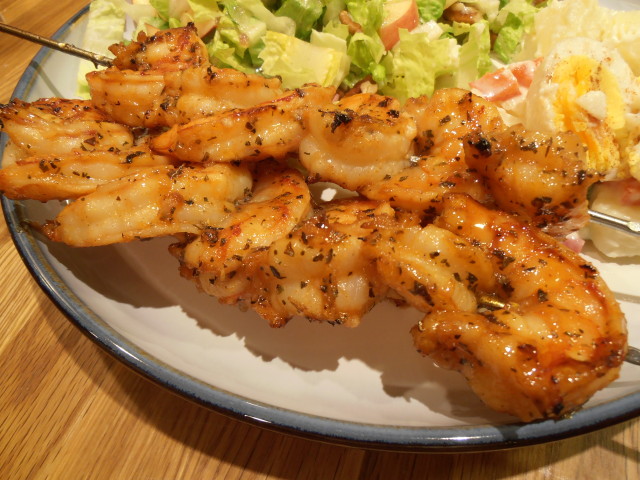
Boaters, Try This Chef’s Recipe!








